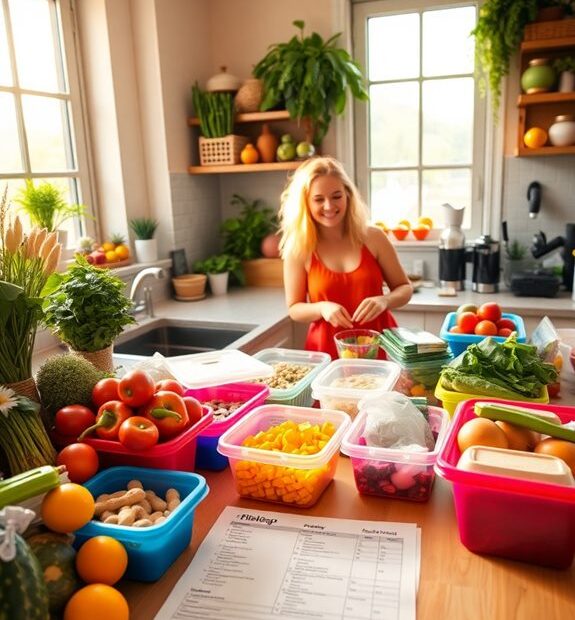Want to succeed at affordable meal planning? Start by assessing your budget. Check grocery ads for sales and create a master grocery list to avoid impulse buys. Using seasonal ingredients can save you money too! Ever tried batch cooking? It's a lifesaver! Choose affordable proteins like beans and eggs for tasty meals. Keep recipes simple with five ingredients or less. Don't forget to organize your meal prep sessions for efficiency. By limiting convenience foods, you'll eat healthier and save cash. Curious about other tips to make meal planning even easier? You're in for a treat! 🍽️
Key Takeaways
- Set a weekly grocery spending limit and review past receipts to identify potential cuts for better budgeting.
- Plan meals around weekly sales and seasonal ingredients to maximize savings and minimize waste.
- Embrace batch cooking to prepare multiple meals at once, saving time and reducing food waste.
- Focus on versatile ingredients like rice and beans that can be used in various recipes to enhance creativity.
- Transform leftovers into new meals, reducing waste and stretching your budget further.
Assess Your Budget
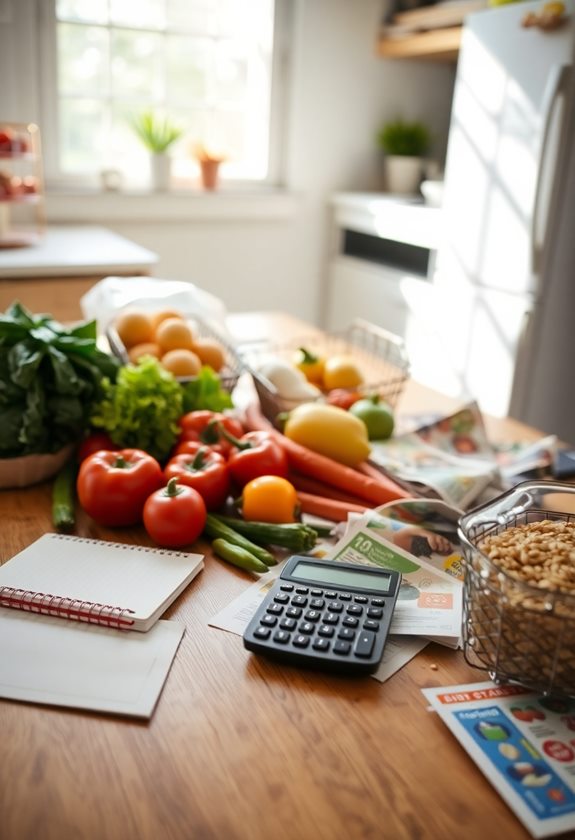
Before diving into meal planning, it's crucial to assess your budget for grocery spending. Have you ever felt overwhelmed by rising grocery prices? You're not alone! Start by figuring out how much you can spend each week. This step keeps you grounded and helps avoid overspending. Consider using resources from guides like budget cooking guides that provide practical tips for managing your grocery costs effectively.
Next, take a look at your past grocery receipts. What do you usually buy? Are there items you could cut back on? For example, if you often buy snacks, could you swap them for healthier, homemade options? This simple change can save you money and improve your diet!
Don't forget to include other costs like toiletries or household items in your budget. It's all part of your grocery spending. Set a budget that works for you, but be flexible. Life happens, and sometimes you'll need to adjust.
Once you've got your budget, stick to it! Challenge yourself to find creative ways to save. Use coupons or shop at discount stores. Remember, meal planning isn't just about meals; it's about making smart choices that fit your financial goals. You've got this!
Plan Around Sales
Once you've set your budget, it's time to plan your meals around sales and discounts. This can save you a lot of money! Start by checking your local grocery store's weekly ads. Do you see any great deals on fruits, veggies, or proteins? Jot down items that are on sale, and reflect on how you can use them in your meals. Utilizing a Weekly Meal Planner Pad can help you organize these ingredients effectively.
For example, if chicken is on sale, you could plan a few chicken dishes for the week. Maybe grilled chicken with roasted vegetables or a hearty chicken soup? When you plan your meals based on what's on sale, you reduce waste and stretch your budget further.
Don't forget to take into account seasonal ingredients too! Fruits and veggies in season are often cheaper and tastier. Plus, they can inspire new recipes you might not have tried.
You could even pick a recipe, then search for its ingredients in the sales ads. It's like a fun little puzzle! By planning around sales, you're not just saving money; you're also getting creative in the kitchen. So, grab those ads and start planning!
Create a Master Grocery List
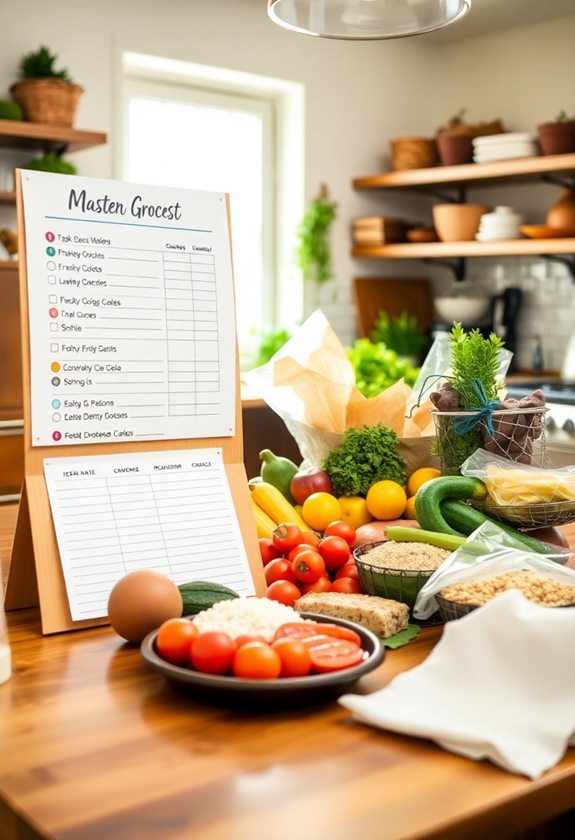
Creating a master grocery list is essential for streamlining your shopping experience and ensuring you stick to your budget. Have you ever wandered the aisles, unsure of what to buy? A master list can help! Start by listing items you regularly use, like pasta, rice, and your favorite veggies. This way, you'll know exactly what you need every time you shop. Consider using a dedicated meal planning notebook to keep your list organized and easily accessible.
Next, consider organizing your list by store sections, like produce, dairy, and grains. This makes your shopping trip quicker and helps you avoid impulse buys. It's easy to get distracted by snacks or sales, right? By sticking to your list, you keep your spending in check.
Don't forget to update your list regularly! Maybe you discovered a new recipe or a product you love. Jot it down as soon as possible so you don't forget for next time.
Use Seasonal Ingredients
Using seasonal ingredients not only enhances the flavor of your meals but also helps you save money. When you choose fruits and veggies that are in season, you're likely to get them at a better price and enjoy their peak taste. Plus, it's a fun way to explore new recipes and flavors throughout the year!
Here are some easy tips to make the most of seasonal eating:
- Visit Local Markets: Farmers' markets often have fresh, in-season produce at great prices. You might even find unique items!
- Check Produce Guides: Look up what's in season for your area. You'll discover which fruits and veggies are currently available.
- Plan Your Meals Around Seasons: If strawberries are in season, think about making a smoothie or a invigorating salad.
- Try Freezing or Canning: If you find a great deal on seasonal produce, consider freezing or canning it for later use.
Embrace Batch Cooking

Embracing batch cooking can revolutionize your meal planning and save you both time and money. Imagine cooking several meals at once instead of every day. Sounds appealing, right? By preparing large portions, you cut down on cooking time, which frees up your evenings for other fun activities!
Start by picking a day, like Sunday, to cook. Choose recipes that freeze well, such as soups, stews, or casseroles. You can also batch cook grains like rice or quinoa. Once everything's cooked, portion your meals into containers. Label them with dates so you know when to use them. This simple step helps prevent waste!
But how do you choose what to cook? Think about your favorite meals. Are they easy to make in bulk? If so, those are perfect candidates for batch cooking! You can even invite friends over to cook together. It makes the process fun and social!
In the end, batch cooking not only fills your fridge but also brings a sense of accomplishment. You'll save money on groceries and time in the kitchen. So why not give it a try? Your future self will thank you! 🍲✨
Incorporate Leftovers Creatively
Leftovers can be a treasure trove of culinary possibilities, transforming a single meal into multiple delicious dishes. Instead of letting your leftovers gather dust in the fridge, why not get creative? By reimagining those uneaten meals, you can save money and time while enjoying new flavors. Here are some fun ideas to get you started:
- Wrap It Up: Turn leftover roasted chicken or veggies into a tasty wrap! Just add some fresh greens, a spread, and you're good to go. 🌯
- Soup It Up: Chop up leftover proteins and throw them into a pot with broth and veggies for a hearty soup. It's warm, comforting, and zero waste! 🍲
- Frittata Fun: Mix leftover meats, veggies, and eggs for a quick frittata. Simple, filling, and perfect for breakfast or dinner! 🍳
- Pasta Remix: Combine leftover grains with sautéed veggies and a sauce for a delicious pasta dish that feels brand new. 🍝
Choose Affordable Proteins
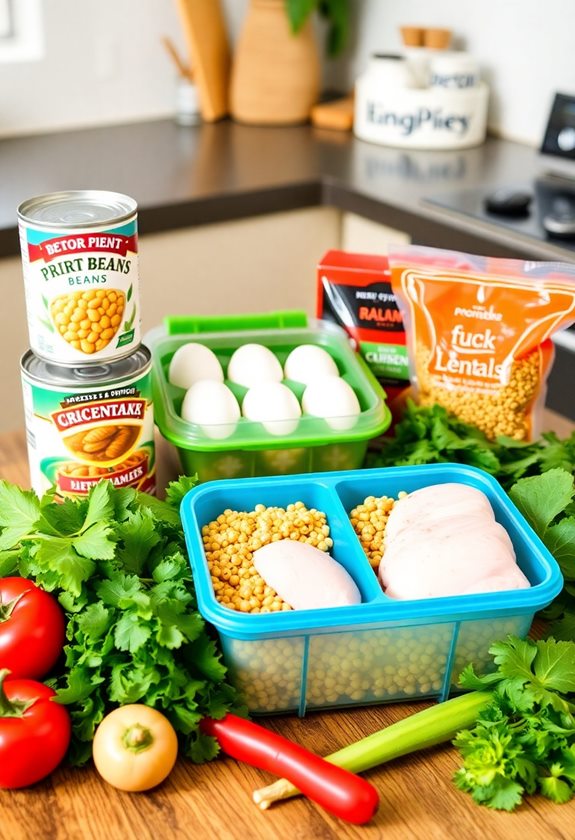
Finding ways to stretch your budget while meal planning starts with the proteins you choose. Proteins can be pricey, but you don't have to break the bank. Have you ever thought about how different proteins can impact your meals? By selecting affordable options, you can save a lot!
Here's a simple table to help you pick budget-friendly proteins:
| Protein Source | Price (per lb) | Cooking Ideas |
|---|---|---|
| Canned Beans | $1.00 | Salads, soups, or stews |
| Eggs | $2.50 | Scrambled, boiled, or frittatas |
| Chicken Thighs | $3.00 | Grilled, baked, or in stir-fries |
Using these options, you can create filling meals without overspending. Why not try mixing different proteins? For instance, combine beans with rice for a tasty, nutritious dish. Or, add eggs to veggies for a quick breakfast!
Simplify Your Recipes
Often, simplifying your recipes can make meal planning more manageable and cost-effective. Who wouldn't want to spend less time cooking and more time enjoying meals? By focusing on simpler recipes, you can save money and stress. Here are four tips to help you simplify your cooking:
- Use Fewer Ingredients: Stick to recipes with five or fewer ingredients. This way, you won't waste food or money on items you won't use again.
- One-Pot Meals: Try one-pot meals like soups or casseroles. They're easy to make, quick to clean up, and often taste even better the next day!
- Batch Cooking: Cook large portions of a meal and freeze leftovers. This saves time and effort for busy days when you don't feel like cooking.
- Embrace Versatile Ingredients: Choose ingredients that can be used in multiple dishes. For example, rice or beans can be added to salads, stir-fries, or wraps.
Limit Convenience Foods
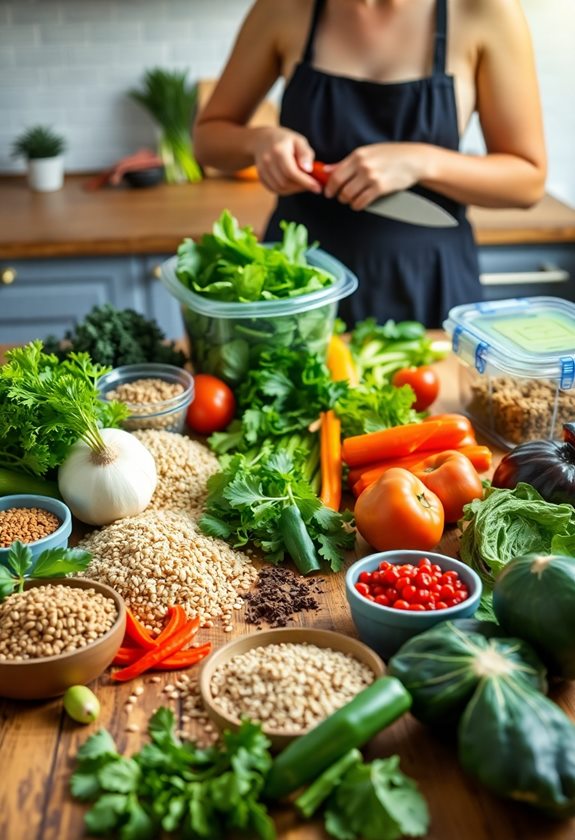
Many people rely on convenience foods for quick meals, but these options can quickly drain your budget. Have you ever checked the price of a frozen dinner? You might be surprised how much they cost compared to fresh ingredients. Instead of grabbing those ready-made meals, consider cooking simple dishes at home.
Limit convenience foods and watch your savings grow! When you make meals from scratch, you control the ingredients and save money. For example, instead of buying pre-packaged salads, buy fresh greens and top them with your favorite veggies. It's cheaper, healthier, and takes just a little more time.
Think about it—what's your favorite meal? Could you make it at home? Chances are, you can! Start small by swapping one convenience item for a homemade version each week. You'll notice the difference in taste and your wallet.
Organize Meal Prep Sessions
Meal prep sessions can be a game changer for your budget and your time. By organizing these sessions, you save money and eat healthier. Ready to jump in? Here are some tips to make your meal prep successful:
- Choose a Day: Pick a specific day each week for meal prep. Sunday works for many, but find what fits your schedule best.
- Make a Plan: Decide what meals you'll cook and create a shopping list. This helps you avoid impulse buys at the store.
- Gather Supplies: Use clear containers for easy storage. Label them with the contents and date to keep things organized.
- Cook in Batches: Cook larger quantities of grains, proteins, and veggies. You can mix and match them throughout the week, making meals quick and easy.
Have you ever noticed how much easier it is to grab a healthy meal when it's ready? With a little planning, you'll find meal prep not only saves you money but also cuts down on stress. So why not give it a try? Your wallet (and your stomach) will thank you! 😊
Frequently Asked Questions
How Do I Involve My Family in Meal Planning?
You're not a lone chef in a kitchen; involve your family like a sitcom cast! Let them pick meals, create a grocery list, and even cook. It's teamwork—plus, you'll avoid the "What's for dinner?" drama!
What Are Some Quick Meal Prep Tips for Busy Schedules?
You can simplify meal prep by choosing quick recipes, prepping ingredients in advance, and batch cooking on weekends. Don't forget to involve your family; they'll appreciate the effort and enjoy the meals together!
How Can I Reduce Food Waste During Meal Planning?
To reduce food waste during meal planning, you can focus on using ingredients efficiently, plan meals around what's in your pantry, and store leftovers properly. It's all about being mindful and creative with your food choices.
Are There Apps to Help With Meal Planning and Budgeting?
You'll find apps that'll revolutionize your meal planning and budgeting, making it feel like you've struck gold! From tracking expenses to suggesting recipes, these tools can turn chaos into culinary harmony. You won't regret trying them!
What Pantry Staples Should I Always Keep on Hand?
You should always keep pantry staples like rice, pasta, canned beans, tomatoes, and spices. These essentials help you whip up quick, delicious meals and save time and money when you're planning your weekly menu.

